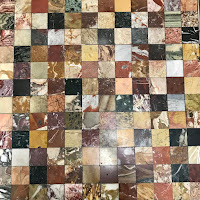Today's featured artifact is a square mahogany specimen table. It was owned by Richard Valentine Morris, son of the more famous Lewis Morris who signed The Declaration of Independence. Being from such a prominent family, Richard Morris had the financial means and status to commission this elaborate piece of furniture. The resulting work of art sports carved legs with urn inlays at the top and rosette inlays at the bottom. The main feature of the table is its top, flaunting 144 square pieces of colored marble held together in a brass frame. The table earns the classification of a 'specimen table' from its array of diverse stones, collected from different excavation sites. Specimen tables were popular among the English elite in the 18th and 19th centuries. Even after America gained its independence, Britain continued to have cultural influence over its former colonies. The elite of America often viewed Europe as the height of culture, emulating their art and decorating their houses in similar styles. Thus, it is not uncommon to see a specimen table, inspired by European models, in America. The main feature of specimen tables is their incorporation of different stone materials (Gowrley).
 During this time, it was common for young men of
elite families to go on Grand Tours of Europe where they had access to fine
marble and granite. This coming-of-age rite served to educate young men in the
classics. Many rich youths traveled to Italy to embrace Roman history and study
Latin. Although Grand Tours were intended as scholarly endeavors, young men
often used their freedom from home as an opportunity to gamble and engage in
promiscuous activities (Howard). The elite also used their time to collect
samples of rocks and marble, later commissioning specimen tables to show off
the findings from their travels. Some of these materials were taken from Roman
excavation sites and made into smaller pieces (Gowrley). The elite’s ability to
not only own but break down artifacts from antiquity shows the privilege of the
individuals who went on Grand Tours. Thus, the specimen tables were a way for
people to show their status and culture.
During this time, it was common for young men of
elite families to go on Grand Tours of Europe where they had access to fine
marble and granite. This coming-of-age rite served to educate young men in the
classics. Many rich youths traveled to Italy to embrace Roman history and study
Latin. Although Grand Tours were intended as scholarly endeavors, young men
often used their freedom from home as an opportunity to gamble and engage in
promiscuous activities (Howard). The elite also used their time to collect
samples of rocks and marble, later commissioning specimen tables to show off
the findings from their travels. Some of these materials were taken from Roman
excavation sites and made into smaller pieces (Gowrley). The elite’s ability to
not only own but break down artifacts from antiquity shows the privilege of the
individuals who went on Grand Tours. Thus, the specimen tables were a way for
people to show their status and culture.
Augustyn, Adam. “First Barbary War.” Encyclopædia
Britannica, Encyclopædia
Britannica, Inc., 7 May
2022, https://www.britannica.com/event/First-Barbary-War.
“The Barbary Wars, 1801-1805.” The Mariners' Museum : Birth of the U.S. Navy, https://www.marinersmuseum.org/sites/micro/usnavy/06/06a.htm.
Gowrley, Freya. “Classical Histories, Colonial Objects: The Specimen Table across Time and Space.” British Art Studies, Paul Mellon Centre for Studies in British Art and Yale Center for British Art, 30 Nov. 2021, https://www.britishartstudies.ac.uk/index/article-index/the-specimen-table-across-time-and-space/article-category/article.
Howard, Jeremy R. “The Role of the Grand Tour.” Encyclopædia Britannica, Encyclopædia Britannica, Inc., 26 Aug. 2021, https://www.britannica.com/topic/art-market/The-18th-century#ref1052123.
LaChiusa, Chuck. “Charles-Honoré Lannuier.” Buffaloah.com, https://buffaloah.com/f/fdesigners/lann/lann.html.
This blog post by Siobhan Nerz, Bucknell University





No comments:
Post a Comment